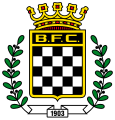Checkerboard pattern
A checkerboard pattern is a flat, geometric pattern . This pattern generally consists of squares , the colors of which alternate both horizontally and vertically.
species
The simplest checkerboard pattern consists of regularly repeating black and white or light and dark squares. A modification of this with regard to the colors that occur is a regular pattern of squares in which more than two colors occur. Regularly repeating patterns of diamonds , triangles or other figures (such as certain patterns by MC Escher ) can be viewed as generalized checkerboard patterns .
history

Checkerboard patterns can already be found on pre-classical Greek vases of the geometric style and in ancient Greek and Roman floor mosaics. The original popularity of this decorative motif has nothing to do with the chess game, which was still unknown at the time; it is very likely that this motif is derived from older braided and woven patterns.
However, with the invention and rapid spread of the game of chess, the popularity of checkerboard patterns increased rapidly.
In the Middle Ages, diamond or checkerboard patterns can be found as background design (e.g. on the Dreikönigsschrein in Cologne Cathedral ) or on church facades (e.g. St-Julien in Chauriat ). Mysterious chessboard pieces can be found on medieval churches in the southern Baltic Sea region and along the Oder . The block friezes so popular in Romanesque architecture can also be understood as - three-dimensional - checkerboard patterns.
symbolism
There are no clear statements about a possible symbolism of checkerboard patterns. But checkerboard patterns as well as block friezes in the broader sense belong to the net and lattice forms, which - depending on the region - are associated with disaster-resistant ( apotropaic ) forces. Above all, the priority application of checkerboard patterns on outside walls, building corners, roof eaves, etc. could serve as an indication for such an interpretation.
use
Because of their easy optical identification, checkerboard patterns were often used in medieval mercenary uniforms , Scottish tartans, etc. as well as in heraldry (see Schacht ).
A practical field of application is the area of machine vision , since checkerboard patterns are suitable for calibrating cameras and objects provided with checkerboard patterns allow a comparatively simple determination of the orientation of the object relative to the camera. The American term checkerboard is often used in this area of application .
Systematically laid out cities (especially in the USA , for example in Manhattan ) also have streets laid out according to a checkerboard pattern ( English grid pattern ), which are divided into streets and avenues and have numerically ordered street names .
Examples
The red and white checkerboard pattern is also considered the national symbol of the Croats and characterizes the national coat of arms , the Šahovnica . There is also a black and white checkerboard pattern in the club crest and dress of the Portuguese football club Boavista Porto .
The Free State of Bavaria also has a checkerboard-like pattern in the flag ( diamond flag ). The checkerboard pattern is also symbol of the on Jamaica incurred dance music Ska . In car races such as Formula 1 , the corresponding flag signals the end of the race.
Some chimneys are marked with several red and white checkerboard patterns as visually striking obstacles to air traffic.
In Germany, some public transport stops used to be tiled in a checkerboard pattern, see stop # Schachbrettmuster
The operation of winter sports special trains was announced locally with a corresponding flag at the departure station.
gallery
Melish pomp amphora with a checkerboard pattern
Checkerboard pattern in the Heilig-Kreuz-Kirche in Frankfurt - Bornheim
Web links
- Antique checkerboard pattern on a Greek amphora
- Antique checkerboard pattern on a Greek vase
- Medieval chessboard stone near Teltow
- Checkerboard pieces on Brandenburg churches - complete photographic display












